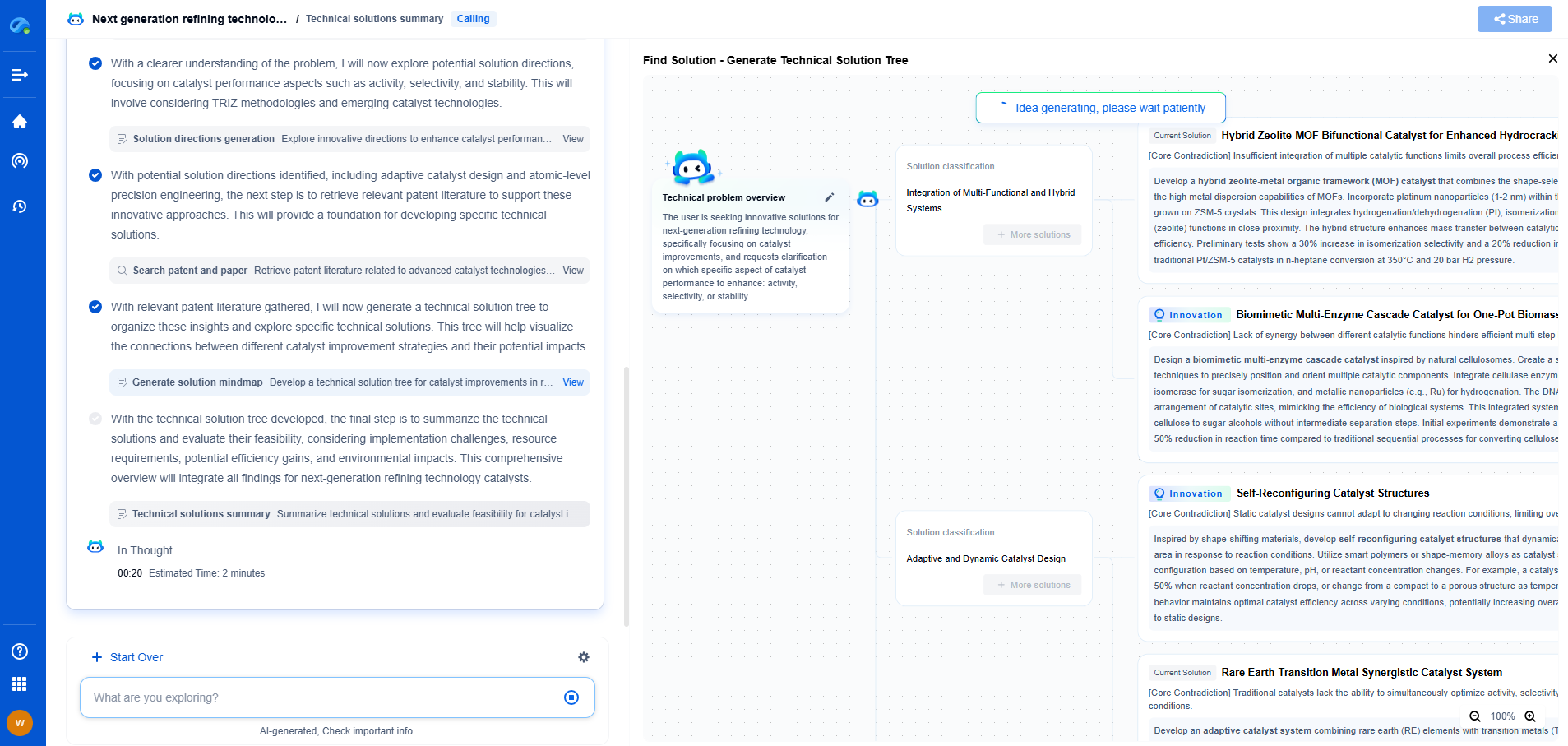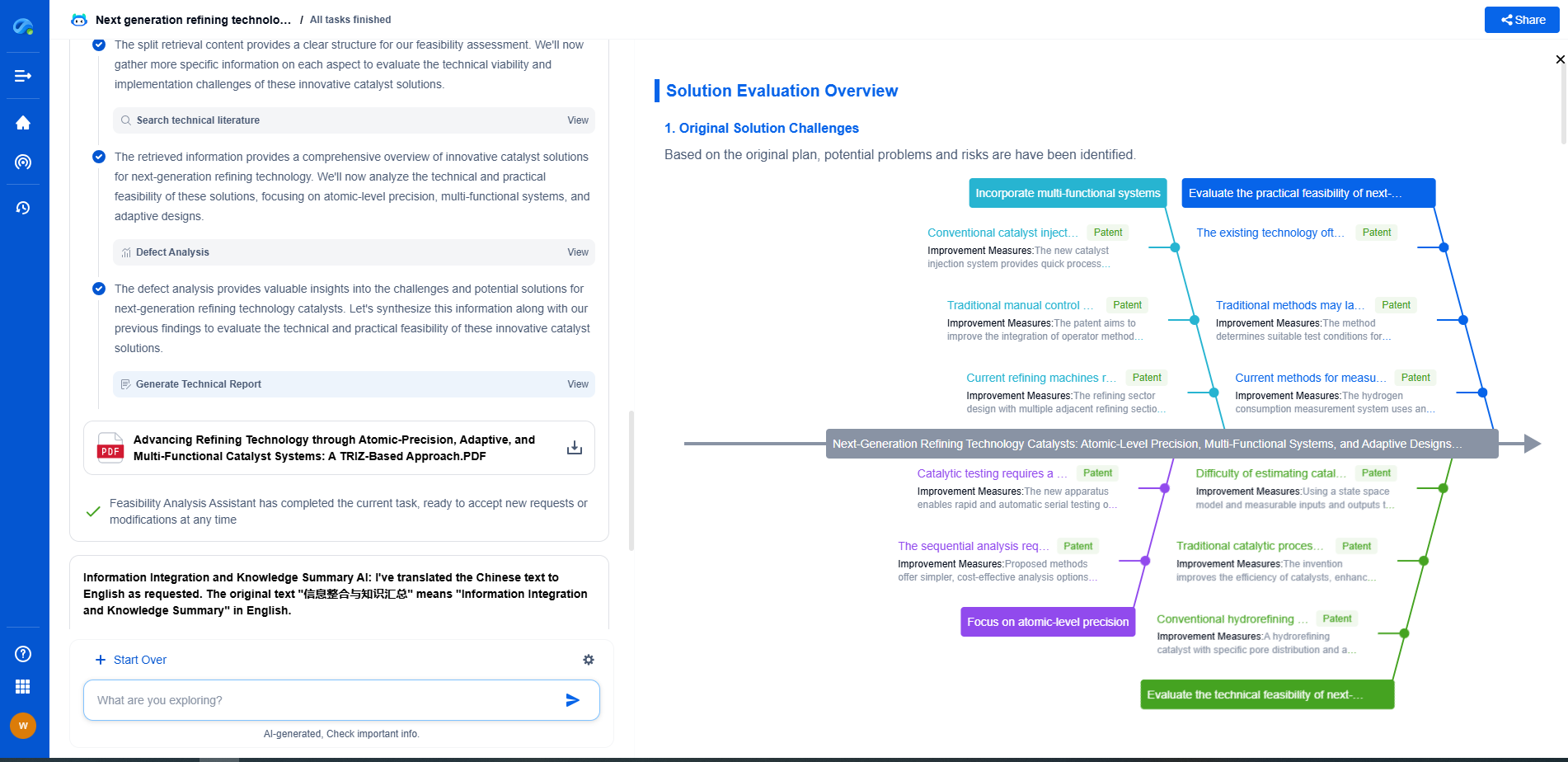MOF vs zeolite membranes: A new era in gas separation?
JUL 25, 2025 |
Gas separation is a crucial process in various industries, including energy, environmental, and chemical sectors. Traditionally, methods like cryogenic distillation and pressure swing adsorption have been the mainstay for separating gases. However, these methods can be energy-intensive, prompting the search for more efficient technologies. Enter membrane technology—a promising alternative offering lower energy consumption and smaller environmental footprints. Among the array of membrane options, Metal-Organic Frameworks (MOFs) and zeolites have emerged as frontrunners in advancing gas separation processes.
Understanding MOF and Zeolite Membranes
Metal-Organic Frameworks (MOFs) are a class of crystalline materials composed of metal ions linked by organic ligands, forming porous structures. The high surface area and tunable pore sizes of MOFs make them highly attractive for gas separation applications. Their modular nature allows for the design of specific structures tailored for particular gas molecules, enhancing selectivity and permeability.
Zeolites, on the other hand, are microporous aluminosilicate minerals. Known for their thermal stability and well-defined pore structures, zeolites have long been utilized in gas separation. Their ability to withstand harsh chemical environments makes them ideal for various industrial applications. The difference in pore structures and chemical compositions between MOFs and zeolites leads to varying performances in gas separation.
Comparing Performance: MOFs vs. Zeolites
When comparing MOF and zeolite membranes, it is essential to focus on their performance metrics: permeability, selectivity, and stability. MOFs offer exceptional tunability in pore structure, which can be precisely engineered to target specific gas mixtures. This flexibility often results in higher selectivity compared to traditional zeolite membranes.
Zeolites, however, are renowned for their durability and stability under extreme conditions. Their robust nature allows them to perform consistently over long periods, making them a reliable choice for industrial applications where harsh conditions are prevalent.
Despite the advantages of each, the choice between MOF and zeolite membranes often hinges on the specific requirements of the separation process. For instance, MOFs might be favored for applications requiring high selectivity, while zeolites may be preferred for their stability and long-term performance.
Recent Advances in MOF and Zeolite Membrane Technology
Recent research has seen significant advances in both MOF and zeolite membrane technologies. For MOFs, the development of hybrid structures and the incorporation of mixed-matrix membranes have shown promise in overcoming issues related to stability and scalability. These innovations aim to combine the selectivity of MOFs with the robustness of polymers, creating membranes that are both efficient and durable.
In the realm of zeolite membranes, advancements in synthesis methods have led to the creation of thinner films with enhanced permeability. Techniques such as secondary growth and post-synthetic modification have improved the performance and application range of zeolite membranes, enabling more efficient gas separations.
Challenges and Future Prospects
Despite their potential, both MOF and zeolite membranes face challenges that need addressing. For MOFs, issues related to stability and cost-effectiveness are significant hurdles. The delicate nature of some MOF structures can lead to degradation under certain conditions, limiting their practical application. Researchers are actively working on developing more robust MOF structures and cost-effective synthesis methods to mitigate these concerns.
Zeolite membranes, while stable, can suffer from limitations in selectivity for certain gas separations. Addressing these selectivity challenges involves refining synthesis techniques and exploring new zeolite compositions.
The future of gas separation lies in the continued development of these membrane technologies. A new era may emerge where hybrid approaches integrate the strengths of both MOFs and zeolites, offering unrivaled efficiency and versatility in gas separation processes.
Conclusion
In the quest for more sustainable and efficient gas separation methods, MOF and zeolite membranes present exciting opportunities. By understanding and leveraging the unique properties of each, industries can achieve more effective separations, reduce energy consumption, and minimize environmental impacts. As research progresses, the lines between the capabilities of MOFs and zeolites may blur, leading to innovative solutions that harness the best of both worlds. The coming years could indeed herald a new era in gas separation, driven by the synergy of MOF and zeolite technologies.
From next-generation membrane materials to high-efficiency separation processes for pharmaceuticals, water treatment, food processing, or energy systems, the filtration & separation industry is rapidly evolving with a surge in material innovation, microstructure design, and process optimization.
Patsnap Eureka, our intelligent AI assistant built for R&D professionals in high-tech sectors, empowers you with real-time expert-level analysis, technology roadmap exploration, and strategic mapping of core patents—all within a seamless, user-friendly interface.
Whether you're designing the next high-throughput filter, optimizing nanostructured surfaces, or exploring new separation media for emerging industries—Patsnap Eureka gives you AI-driven insights in seconds, helping you move from ideation to innovation with confidence.
🚀 Start your free trial today and experience how Eureka transforms filtration innovation—from reactive to predictive.
- R&D
- Intellectual Property
- Life Sciences
- Materials
- Tech Scout
- Unparalleled Data Quality
- Higher Quality Content
- 60% Fewer Hallucinations
Browse by: Latest US Patents, China's latest patents, Technical Efficacy Thesaurus, Application Domain, Technology Topic, Popular Technical Reports.
© 2025 PatSnap. All rights reserved.Legal|Privacy policy|Modern Slavery Act Transparency Statement|Sitemap|About US| Contact US: help@patsnap.com

